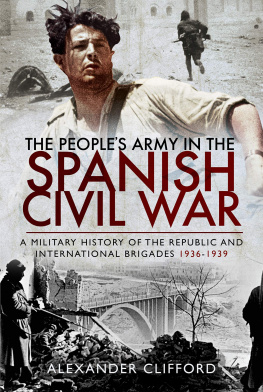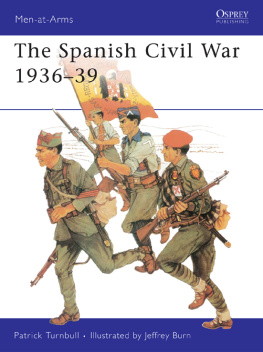Foreword
Speak of me as I am. Nothing extenuate, nor set down aught in malice. Othellos appeal might well be invoked by the Spanish Foreign Legion, also known as El Tercio. Few military forces have been so comprehensively vilified; fewer still have been systematically analyzed. lvarez thus presents a study unique in English and unusual in Spanish: an account of the Legions crucial, indeed decisive, role in the Spanish Civil War.
Between July and December 1936 this force of fewer than four thousand men, organized in only six battalions, or banderas, enabled the consolidation of the Nationalist revolt against the Spanish Republic, spearheaded a lightning offensive that secured Nationalist control of half the country, confirmed its exponential superiority as a combat force over the republics improvised levies, and established a nearly mythical reputation for ferocity that endures to this day.
That is quite a legacy, military and cultural. lvarez takes an operational perspective to explore the Legions underlying realities in two contexts. The first is from the greater world of politics and political ideology. The Spanish Republic was unusually skilled at demonizing its opponents, and the Spanish Foreign Legion was a nearly perfect target. Created in 1920 as an instrument of empire for deployment in Spanish Morocco, the Legion had always stood apart from the rest of the Spanish Army. It had never been deployed in Spain until 1934, when a leftist-inspired revolution against the newly established republican government led to the dispatch of two of its banderas to the province of Asturias. The legionnaires pacified the region quickly and brutally, leaving behind more than a thousand casualties and an immense destruction of property. They returned to Africa with an evil reputation, reinforced by a governmenteager to disassociate itself from the unsavory details accompanying its counterinsurgency.
When the Legion came to Spain again in 1936, this time as part of the Nationalist revolt, its infamy preceded itand was reinforced by the relative ease with which the Legions banderas eviscerated their opponents. To explain this in terms of inadequate command, training, and discipline was impossible for a republic hanging on almost day by day. Instead the Legion was cast as an alien force: victorious only by systematically violating every rule and convention of warfare.
This isolation of the Spanish Foreign Legion was completed by the formation of the republics International Brigades. As these rapidly became, for publicity purposes, the heroic focal point of the republics military effort, the Legion found a new place as the brigades evil counterpart. The process was facilitated by the nearly universal conflation of the Spanish Foreign Legion with the French Foreign Legion. Both were described as composed of outcasts from the four corners of the globe: mercenary aliens with murky pasts and no futures.
This image had little to do in reality with a Spanish Legion that was almost entirely indigenous in composition and whose internal dynamic was as far from the French legion of the damned as it was possible to get. But the image contributed heavily to the Republican depiction of the Nationalists as aliennot belonging to the real Spain. The image has also survived, particularly in English-language works on the war.
If these were the megamyths surrounding the Spanish Foreign Legion, what were the microrealities from the lesser world of barracks and battlefield? The Legion was created when Spains military reputation was at its nadir, after a series of unredeemed disasters in Morocco. The Legions dynamic was intended to be the exact opposite of a peninsular army that appeared to have forgotten how to fight and was lost to shame and dishonor. The Legion was tailored to the specific conditions of Morocco, where the Rif War of the early 1920s had evolved at the sharp end into a no-quarter death grapple of raid and reprisal.
Strict discipline, pitiless toughness, and ferocity in combat characterized the Spanish Foreign Legion from its inception, and those qualities were embedded in a cult of elitism. The Legions historical aspects evoked the Spanish Army of the early modern era, the formidable tercios (regiments). The Legions Catholicism was more an institutional signifier thana theological conviction. Pay and food in the Legion were significantly better than in either the regular army or most unskilled civilian jobs.
The Legions ranks in 1936 were filled not by ideologically motivated foes of the republic but by men who joined for the same reasons that elite forces still attract recruits: to escape civilian routines, to serve under authorities one can respect, to test oneself against extreme demands, and, not least, just for the hell of it! lvarez goes so far as to speak of the Legions institutional necrophilia: its motto of Long live death, its public self-image as the betrothed of death, and its signature bugle call, Legionnaires to fight, legionnaires to die. The ethos of the Legion strongly resembles that of the matador, to someone outside both of those subcultures: the ultimate contest is not with the bull or another adversary but with the self, culminating in a moment of truth that calls for the ultimate in discipline, training, courage, and will.
Violence and brutality were thus central to the Spanish Foreign Legions culture from its formation, and this fitted admirably into the Nationalist policy of pacification by fear and terror. The Legions policy toward taking prisoners resembled that of the Japanese Army in China: accepting surrender was a matter of circumstance and convenience. Behind the lines, Legion participation in large-scale arrests and mass executions were the norm, frequently justified as reprisals for the behavior of Republican mobs or authorities, but a good deal more systematic. Arrest was accompanied by equally systematic looting. Such plunder had been a recognized perquisite during the Rif War. The Regulares, the Moroccan soldiers recruited by Spain to fight alongside the Legion, were (like their French counterparts) expected to supplement their pay with booty. Nor were the legionnaires behind the Regulares in their treatment of captives whom their right hand possessedthat is, any women who took the soldiers fancy.
The Spanish Foreign Legion, in short and to say the least, did not bear a clean shield. What it did do was apply for the first time a method of making war that has repeatedly redrawn the map of Europe and the world: motorized war. Blitzkrieg is so often linked to mechanization, the large-scale use of armored fighting vehicles, that it becomes easy to overlook the more fundamental role of the internal-combustion engine.
The Spanish Army of Africa was anything but a center of modern transport technology. Mules were the basic load bearers in Africa, butwhen deployed to Spain the army faced two fundamental problems: a massive imbalance with the number of adversaries, and a disproportionate amount of ground to secure. The Spanish Republic maintained much of the framework of the peninsular army, supplemented and then swamped by a motley collection of militias whose enthusiasm offered at least the potential of developing combat effectiveness. The Nationalists had the Legion, about the same number of Regulares, and the odds and ends of the peninsular units in southern Spain that had neither remained loyal to the republic nor been disarmed and disbanded.














 This paper meets the requirements of the American National Standard for Permanence of Paper for Printed Library Materials, Z39.48, 1984.
This paper meets the requirements of the American National Standard for Permanence of Paper for Printed Library Materials, Z39.48, 1984.